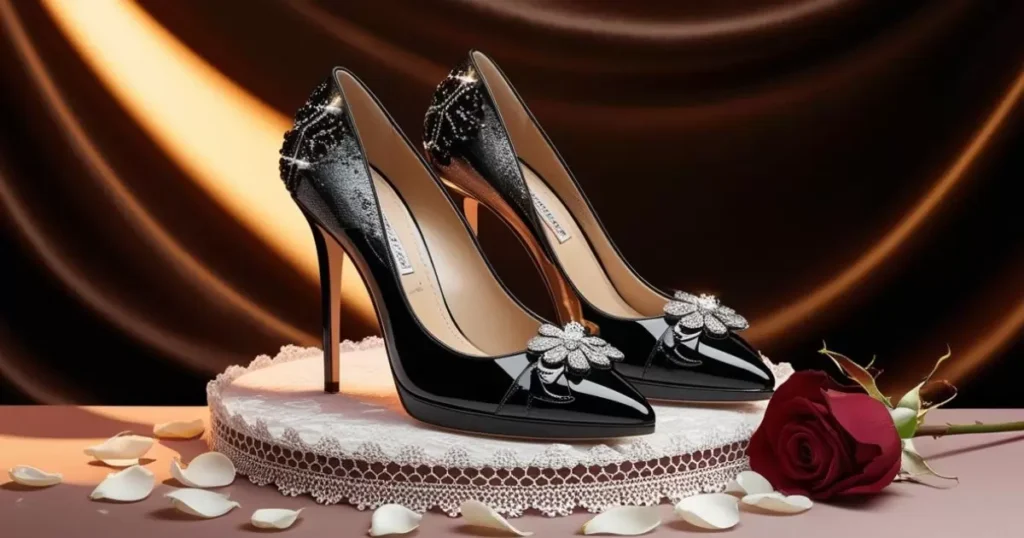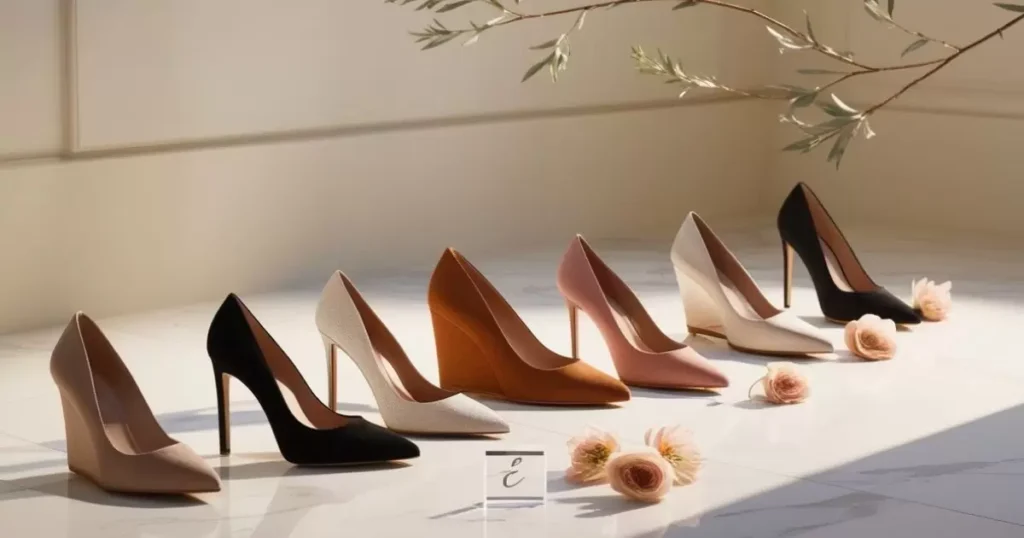In the vast world of fashion, few items are as essential and diverse as shoes. From the runways of Paris to the streets of New York, footwear isn’t just about protection—it’s a statement, a comfort zone, and sometimes even a work of art. This comprehensive guide will walk you through the ins and outs of shoe types, helping you put your best foot forward in any situation.
Introduction: Stepping into the World of Footwear
Shoes have come a long way since our ancestors first wrapped animal hides around their feet for protection. Today, they’re a multi-billion dollar industry, with styles ranging from the purely functional to the outrageously avant-garde.
Did you know? The oldest known shoe, discovered in Armenia, dates back to around 3500 BCE!
Understanding different shoe types isn’t just about fashion—it’s about comfort, functionality, and making smart investments in your wardrobe. Whether you’re a sneakerhead, a high-heel enthusiast, or just someone looking for comfortable work shoes, this guide has got you covered.
The Sole of the Matter: Shoe Anatomy 101
Before diving into specific types, let’s break down the basic anatomy of a shoe:
- Upper: The part that covers the top of your foot
- Sole: The bottom part that contacts the ground
- Insole: The inner part where your foot rests
- Outsole: The outermost layer of the sole
- Midsole: The layer between the insole and outsole (common in athletic shoes)
- Heel: The raised part at the back of the shoe
- Toe box: The area that houses your toes
The construction of a shoe significantly affects its comfort, durability, and suitability for different activities. For instance, a running shoe with a cushioned midsole absorbs shock, while a dress shoe with a leather sole offers elegance and a classic look.
Lace ‘Em Up: Athletic Shoes
Athletic shoes have revolutionized footwear, blending technology and style for peak performance.
Running Shoes: Sprinting Ahead of the Pack
Modern running shoes are marvels of engineering. They typically feature:
- Breathable mesh uppers
- Cushioned midsoles (often with proprietary foams like Nike’s ZoomX or Adidas’s Boost)
- Reinforced heel counters for stability
- Outsoles designed for specific terrains (road, trail, track)
Pro tip: Replace your running shoes every 400-500 miles to maintain optimal support and cushioning.
Cross-trainers: Jack-of-all-trades
Cross-trainers are versatile athletic shoes designed for various activities. They offer:
- Lateral support for side-to-side movements
- Moderate cushioning for impact absorption
- Durable construction for diverse workouts
Sport-specific Kicks: From Court to Field
Different sports require specialized footwear:
- Basketball shoes: High-tops for ankle support, cushioning for jumps
- Soccer cleats: Studs for traction, thin uppers for ball control
- Tennis shoes: Non-marking soles, reinforced toes for quick stops and pivots
Dressed to Impress: Formal Footwear

When it’s time to suit up, these are the shoes that’ll complement your sharpest looks.
Oxfords: The Timeless Classic
Oxfords are characterized by their closed lacing system, where the eyelet tabs are stitched under the vamp. They’re sleek, elegant, and perfect for formal occasions.
Types of Oxfords:
- Plain-toe
- Cap-toe
- Wingtip
- Whole-cut
Brogues: Punching Above Their Weight
Brogues are distinguished by decorative perforations (broguing) on the upper. Originally designed for Irish farmers to drain water from their shoes, they’ve become a stylish option for both formal and semi-formal wear.
Monk Straps: Buckling Down on Style
Monk strap shoes forgo laces in favor of a buckle closure. They come in single or double strap varieties and offer a unique blend of formal and fashion-forward.
Dress Boots: Elevating the Game
Dress boots bring a touch of ruggedness to formal wear. Popular styles include:
- Chelsea boots
- Chukka boots
- Balmoral boots
Workhorses: Shoes That Mean Business
For those who spend long hours on their feet, the right work shoe can make all the difference.
Steel-toed Boots: Safety First, Style Second
Steel-toed boots are essential in many industries. They feature:
- Reinforced toe caps (steel, composite, or alloy)
- Slip-resistant soles
- Durable, water-resistant uppers
Safety standards: Look for ASTM F2413-18 certification in the US for workplace safety compliance.
Slip-resistant Shoes: Gripping the Workplace
Popular in food service and healthcare, these shoes offer:
- Specially designed outsoles with intricate patterns
- Materials that provide traction on wet or oily surfaces
- Comfortable cushioning for long shifts
Orthopedic Options: Comfort for Long Shifts
Orthopedic work shoes prioritize foot health with:
- Extra arch support
- Roomy toe boxes
- Shock-absorbing soles
Kicking Back: Casual Footwear

When comfort is key, these shoes deliver style without sacrificing ease.
Sneakers: From Playground to Runway
Sneakers have transcended their athletic origins to become fashion staples. Popular styles include:
- Low-top canvas (like Converse Chuck Taylors)
- Retro-inspired (like Nike Air Jordans)
- Minimalist leather (like Common Projects)
Loafers: Slipping into Laid-back Luxury
Loafers offer slip-on convenience with a touch of class. Variations include:
- Penny loafers
- Tassel loafers
- Horsebit loafers
- Driving moccasins
Boat Shoes: Nautical but Nice
Originally designed for use on slippery boat decks, boat shoes feature:
- Non-marking rubber soles with siping for traction
- Water-resistant leather uppers
- 360-degree lacing system
Espadrilles: Summer’s Favorite Footwear
These casual slip-ons typically have:
- Canvas or fabric uppers
- Flexible, rope-like jute soles
- A laid-back, beachy vibe
Specialty Shoes: When Ordinary Won’t Cut It
Some activities demand footwear that goes beyond the everyday.
Dance Shoes: Twinkle Toes and Tap Shoes
Dance shoes are as varied as dance styles themselves:
- Ballet slippers: Lightweight, flexible, with a split sole
- Tap shoes: Hard soles with metal taps for percussion
- Ballroom shoes: Suede soles for smooth movement, often with elevated heels
Climbing Shoes: Scaling New Heights
Rock climbing shoes are characterized by:
- Tight fit for sensitivity
- Sticky rubber soles for grip
- Downturned shape for precision on small holds
Bowling Shoes: Striking a Balance
Bowling shoes feature:
- Slide soles on one or both feet
- Durable construction to withstand frequent use
- Rental-specific designs with easy-to-clean materials
Boot Camp: Types of Boots
Boots combine style with practicality, offering protection and fashion in one package.
Chelsea Boots: The Beatles’ Favorite
Chelsea boots are ankle-high with elastic side panels. They offer:
- Easy slip-on, slip-off wear
- Versatile style suitable for casual and semi-formal occasions
- Sleek silhouette popularized by 1960s mod culture
Chukka Boots: Desert Storm of Style
Chukka boots typically feature:
- Ankle-high design with two or three eyelets
- Suede or leather uppers
- Originated as off-duty wear for polo players
Cowboy Boots: Riding High on Fashion
Iconic Western footwear, cowboy boots boast:
- High shafts (10-14 inches)
- Pointed toes
- Stacked heels
- Decorative stitching or inlays
Hiking Boots: Conquering the Great Outdoors
Built for rugged terrain, hiking boots offer:
- Ankle support
- Water-resistant or waterproof materials
- Aggressive tread patterns for traction
- Reinforced toe caps for protection
Sandals: Letting Your Toes Breathe
When the weather heats up, sandals keep feet cool and comfortable.
Flip-flops: Beach Basics
Simple and ubiquitous, flip-flops feature:
- Y-shaped strap
- Flat sole
- Minimal design perfect for casual wear
Gladiator Sandals: Warrior Chic
Inspired by ancient Roman footwear, gladiator sandals have:
- Multiple straps extending up the ankle or calf
- Flat soles
- A bold, eye-catching design
Birkenstocks: Comfort’s Comeback Kid
These German-engineered sandals are known for:
- Contoured cork footbeds that mold to the wearer’s feet
- Wide straps for support
- Durable construction that improves with wear
Heels and Wedges: Elevating Your Style

Heels add height and elegance, transforming any outfit.
Stilettos: Sky-high and Sultry
Characterized by their thin, high heel, stilettos:
- Range from 1 inch to over 8 inches in height
- Offer a dramatic leg-lengthening effect
- Require practice to walk in comfortably
Kitten Heels: Purr-fect Compromise
Kitten heels provide a touch of elegance with more stability:
- Typically 1.5 to 2 inches high
- Slender heel shape
- Versatile for both day and evening wear
Block Heels: Steady as She Goes
Block heels offer style with increased stability:
- Wide, square-shaped heel
- Various heights available
- More comfortable for extended wear than stilettos
Wedges: The Comfortable Height Boost
Wedges feature a solid heel that extends from the back of the shoe to the middle or front:
- Distribute weight more evenly than traditional heels
- Available in various heights and styles
- Popular for both casual and dressy occasions
Flats: Style Without the Strain
Flats offer comfort without sacrificing style, perfect for everyday wear.
Ballet Flats: Pirouetting Through Life
Inspired by ballet slippers, these shoes feature:
- Minimal heel
- Rounded toe
- Often adorned with a small bow or other decorative element
Moccasins: Native Charm
Originating from Native American footwear, moccasins offer:
- Soft, flexible soles
- Supple leather uppers
- Slip-on design, sometimes with laces for decoration
Mary Janes: Schoolgirl Chic Grows Up
Mary Janes are characterized by:
- A strap across the instep
- Rounded toe
- Flat or low heel
Material World: What Your Shoes Are Made Of
The materials used in shoe construction greatly affect their performance, comfort, and sustainability.
Leather: The Skin Game
Leather remains a popular choice for its durability and ability to mold to the foot. Types include:
- Full-grain leather
- Top-grain leather
- Suede
- Nubuck
Pro tip: Always use a leather conditioner to keep your leather shoes supple and extend their lifespan.
Synthetics: High-tech Treads
Synthetic materials offer performance benefits and are often more affordable:
- Nylon and polyester for lightweight strength
- EVA (Ethylene-vinyl acetate) for cushioning
- TPU (Thermoplastic polyurethane) for durability and flexibility
Textiles: Weaving Comfort and Style
Fabric shoes offer breathability and unique textures:
- Canvas for casual sneakers
- Knit materials for athletic shoes
- Wool for comfort and temperature regulation
Vegan Options: Cruelty-free Kicks
As demand grows, so do the options for vegan footwear:
- Synthetic leathers (e.g., “pleather”)
- Plant-based materials like Piñatex (made from pineapple leaf fibers)
- Recycled plastics
Shoe Construction: Building Better Footwear
The way a shoe is put together affects its durability, comfort, and repairability.
Goodyear Welt: The Gold Standard
This method involves:
- A strip of leather (the welt) sewn around the perimeter of the outsole
- Allows for easy resoling, extending the life of the shoe
- Provides excellent water resistance
Blake Stitch: Italian Finesse
The Blake stitch method:
- Stitches the upper directly to the sole
- Creates a sleeker profile than Goodyear welting
- Is common in Italian dress shoes
Cementing: Affordable and Flexible
Cementing involves:
- Gluing the upper directly to the sole
- Offers flexibility and lightweight construction
- Is less durable and harder to repair than welted construction
Vulcanization: Rubber Meets the Road
Popular in sneakers, vulcanization:
- Uses heat to bond rubber soles to canvas or leather uppers
- Creates a durable, flexible bond
- Is common in brands like Converse and Vans
TLC for Your Kicks: Shoe Care 101
Proper care can significantly extend the life of your shoes.
Leather Love: Conditioning and Polishing
For leather shoes:
- Clean with a damp cloth
- Apply leather conditioner to prevent drying and cracking
- Polish for shine and protection
- Use shoe trees to maintain shape
Suede Savvy: Brushing and Protecting
To care for suede:
- Brush regularly with a suede brush
- Use a suede eraser for stubborn marks
- Apply suede protector spray
- Avoid water exposure
Sneaker Upkeep: Keeping It Fresh
For athletic and casual sneakers:
- Spot clean with mild soap and water
- Use a soft brush for textured areas
- Clean laces separately or replace them
- Deodorize with baking soda or specialized products
Storage Solutions: Preserving Your Collection
Proper storage is key:
- Use shoe trees for leather shoes
- Store in a cool, dry place away from direct sunlight
- Use shoe bags to prevent dust accumulation
- Avoid stacking heavy shoes on top of delicate ones
Finding Your Fit: Tips for Shoe Shopping

Getting the right fit is crucial for comfort and foot health.
Measuring Up: Getting Your True Size
- Have your feet measured regularly, as size can change over time
- Measure both feet, as they may be different sizes
- Consider width as well as length
Time of Day Matters: When to Try on Shoes
- Shop for shoes in the afternoon or evening when feet are slightly swollen
- This ensures a comfortable fit throughout the day
Break-in Basics: From Stiff to Comfortable
- Wear new shoes around the house before taking them out
- Use thick socks or a hairdryer to gently stretch tight spots
- Be patient—quality leather shoes can take time to fully break in
Conclusion: Best Foot Forward
From the boardroom to the hiking trail, the right shoe can make all the difference in comfort, performance, and style. By understanding the various types of shoes, their construction, and how to care for them, you can build a versatile and long-lasting footwear collection.
Remember, investing in quality shoes and taking good care of them not only enhances your style but also promotes foot health and comfort. So step out with confidence, knowing you’ve got the knowledge to choose the perfect shoes for any occasion.
Whether you’re a sneakerhead, a stiletto enthusiast, or just someone looking for comfortable everyday shoes, there’s a perfect pair out there for you. Happy shoe shopping!
Frequently Asked Questions
What are sneakers?
Sneakers are casual shoes designed for sports or exercise but often worn for everyday use as well. They provide comfort and flexibility.
What are dress shoes?
Dress shoes are formal, polished shoes usually made of leather that are intended to be worn for business attire, church, or other dressy occasions. Examples include oxfords, loafers, and dress boots.
What are sandals?
Sandals are open-toed or open-heeled shoes held on the foot by a strap or thongs that pass between the first and second toes. They provide ventilation and are suitable for warm weather.
What are heels?
Heels are shoes that have a heel raised at the back. They come in various heights and styles and are typically worn by women, though some men’s styles include heels as well. Heels change your posture and make your legs appear longer.
What are boots?
Boots are shoes that cover the foot and lower leg up to below or above the knee. They provide protection from elements like rain, snow, mud, and debris. Common boot styles include riding boots, cowboy boots, rain boots, and winter boots.

An author is a creator of written content, producing works ranging from books and articles to blog posts and essays. They use their creativity, knowledge, and research to inform, entertain, or persuade readers. Authors often have a unique voice and perspective, contributing significantly to literature and various media.

